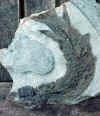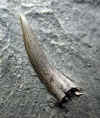|
Next Page
SARCOPTERYGII
Osteolepiformes,
Rhizodontiformes and the Panderichthyida
Osteolepiformes
Osteolepiform fish are thought to the ancestors of the
tetrapods because of the structure of their paired fins and also because they
may have had choanae ( an intrabuccal opening – possible posterior nostril (excurrent))
possibly shared with the tetrapods. Despite there being numerous species,
structurally they where quite homogeneous. There are two recognised clades, the
Tristichopteridae (Eusthenopteridae) and Megalichthyids, although the early
cosmine covered ‘osteolepid’ fish (inc
Osteolepis, Gyroptychius and thursius) are unable to fit into a clade and are
probably paraphyletic. They
are first seen in the Emsian or Eifelian as Cosmine covered osteolepids, reached
their maximus diversity in the Mid/Late Devonian and by the Late Carboniferous
only the large megalichthyids
remained.
The Tristichopteridae include the much celebrated Eusthenopteron foordi
from Miguasha in
Canada
made famous by Jarvik, who spent almost quarter of a century studying it.
Eusthenopteron has lost the cosmine of the osteolepids, has a somewhat
diphyceral tail (shared with
Gyroptychius) compared to epiceral tail of Osteolepis,
has more angular posteriorly placed dorsal fins and an elongated snout
(although juveniles have a shorter snout).
Osteolepiformes in my collection
(click on thumbnails to see larger images)
Tristichopterus
alatus Egerton,
Mid Devonian, Scotland



Osteolepis macrolepidotus,
Mid Devonian, Orkney,
Scotland


 Lethen-bar, Scotland
Lethen-bar, Scotland
 Images from
Catalogue of Fossil Fishes AS Woodward 1891
Images from
Catalogue of Fossil Fishes AS Woodward 1891
Gyroptychius agassizi, Mid
Devonian, Orkney, Scotland

Thursius pholidotus Mid
Devonian, Murkle Bay, Scotland

Eusthenopteron foordi
Upper
Devonian, Escuminac Formation, Miguasha, Quebec, Canada








 Cannibalism plate
Cannibalism plate
 Megalichthys sp. tooth, Carboniferous, Bearsden,
Scotland
Megalichthys sp. tooth, Carboniferous, Bearsden,
Scotland
Rhizodontiformes
Known from fossils within the Coal measures since the
middle of the last century, the name is derived from ‘root – tooth’
because of the the huge fangs that extend deeply into their jaws.
Their pectoral fins were strong and shared the basic structure of having
a humerus, ulna and radius with the osteolepiformes and later tetrapods. They
first appear in the Mid Devonian but peaked in diversity and size in the
Carboniferous. Rhizodus from
Scotland
reached 6 – 7 m in length with a 1 m jaw and 22 cm fangs.
 Rhizodus hiberi Carboniferous,
Cowdenbeath, Scotland
Rhizodus hiberi Carboniferous,
Cowdenbeath, Scotland

 Rhizodopsis, Scales and skull, Carboniferous, Bearsden
Rhizodopsis, Scales and skull, Carboniferous, Bearsden
Panderichthyida
Made up of only 5 species these fish seems to lie between the early tetrapods
and the Osteolepidiformes. They are characterised by thickening of the
postfrontal plates median to the eyes, the median rostral does not contail the
premaxilla, they have a large media gular plate and a lateral recess in the
nasal capsule. Panderichthys from Lode in
Latvia
and Elpistostege from Miguasha in
Canada
are the best know examples. They have many Tetrapod-like features such as a
large, broad, flattened skull (25 pct of the total length of the fish) with
closely spaced eyes on the top, labyrinthodont plicidentine in the teeth, a
fused intercranial joint, a long and strongly ossified humerus (and many more).
They do however retain many fish-like features as well.
|  Images from
Catalogue of Fossil Fishes AS Woodward 1891
Images from
Catalogue of Fossil Fishes AS Woodward 1891
 Megalichthys sp. tooth, Carboniferous, Bearsden,
Scotland
Megalichthys sp. tooth, Carboniferous, Bearsden,
Scotland
 Rhizodus hiberi Carboniferous,
Cowdenbeath, Scotland
Rhizodus hiberi Carboniferous,
Cowdenbeath, Scotland

 Rhizodopsis, Scales and skull, Carboniferous, Bearsden
Rhizodopsis, Scales and skull, Carboniferous, Bearsden













